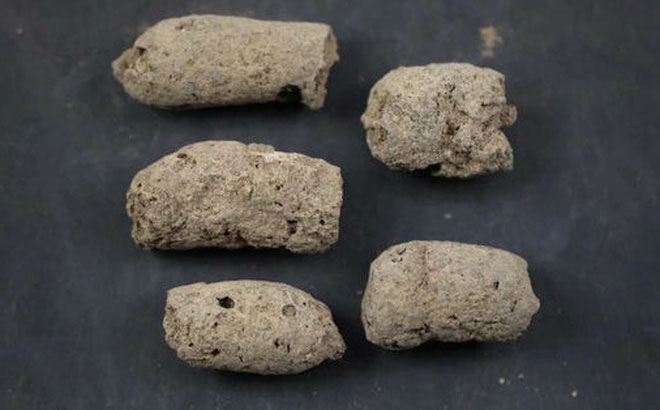This is a way to tell if a '7,000 year old manure' belongs to a dog or prehistoric person
It is known that humans and dogs lived together about 12,000 years ago. Therefore, fossil waste found, has long been a difficult question to answer when it is not easy to distinguish whether it is "human feces" or "dog feces".
And an artificial intelligence system (AI) called "CoproID" was invented, to use machine learning technology to solve this difficult distinction.

Fossil fertilizers have the scientific name of Coprolites.
Fossil fertilizers have the scientific name of Coprolites , as the name implies. Not only is the DNA of the excretion but also the DNA of food and intestinal bacteria is "encapsulated" in this fossil. So it is an excellent archaeological document, which can help professionals understand the diet and health status at that time.
However, for a long time, scientists have shown that this amazing archaeological material is almost impossible to identify as a human or a dog. Because the problem is that dogs often excrete the same faeces as humans, because they follow the same diet as their owners and sometimes the animals also eat human feces. And sometimes people eat dog meat. By doing so, it is almost impossible to determine whether the DNA contained in fossil fertilizer is human or dog.
To solve this problem, joint research groups from the Max Planck Institute of Human History, Durham University, Harvard University, and Oklahoma University . have collaborated to use machine learning technology to distinguish the difference between "human feces" and "dog feces". They developed an artificial intelligence system called "CoproID". This AI will identify fecal fossils by comparing DNA in modern feces with DNA in fecal feces.
The team examined whether 13 fossil fossils excavated from 10 archeological sites in Mexico, China, Europe . could accurately detect non-fecal stones. A discriminatory test was performed on a total of 20 samples with the addition of 7 fecal samples. The oldest fecal rock used in the test is about 7,200 years old, excavated from 10 archaeological sites in Mexico, China and across Europe. Thirteen of them are fossilized fertilizers and the remaining 7 samples are sediments, which were included to try to disturb the CoproID.
Test results show that CoproID has identified 5 samples from humans on 13 fecal fossils, 2 samples of dogs and the remaining 6 samples "unspecified" . On the other hand, they also concluded that all seven sediment samples were not fossilized fertilizers.

Fossil fertilizers were used in the experiment.
Of the 6 "unidentified" fossil samples , 3 did not contain enough DNA to identify them as human or dog. The other three samples, from a 1,300-year-old archaeological site in Mexico, contain a gut microbiome that is human-friendly, but also contains dog DNA. The team made an inference about these three samples: "Either the feces of people who ate dog meat, or the feces of dogs with intestinal microflora completely different from modern dogs."
Because unlike dogs that eat pet food at the same time each day, stray dogs often take their food from garbage in urban areas or hunt in the wild. Therefore, they can have completely different microorganisms in the gut.
" To improve the accuracy of CoproID determination, further advances in dog gut microbiota studies are needed," said Maxime Bilty, a PhD student in biological sciences at the Institute of Historical Sciences. Humanity Max Planck, said.
The team plans to add new data to CoproID in the future to improve the accuracy of the judgments made by AI.
- What is carbon isotope analysis? Why is it possible to date the archeology?
- Discovered astonishing human traces in North America 24,000 years ago
- Earn $ 13,000 / year thanks to ... selling your own manure
- Giant prehistoric crocodile
- Remnants of prehistoric people at Dong Van stone plateau
- Pet manure can generate electricity for millions of people
- Producing electricity from chicken manure
- Discovered a 3,000-year-old bottle of prehistoric children
- Cow dung will help you no longer have headache because of gas price?
- The relics in the volcanic cave have bones of prehistoric people in Dak Nong
- Reveal the time of breastfeeding of prehistoric people
- Why are prehistoric animals so much bigger than animals today?
- Warning for H7N9 flu can spread from person to person
- The 125 million-year fossil remains intact, the hair of prehistoric mice
 Discovered an ancient centipede fossil 99 million years old
Discovered an ancient centipede fossil 99 million years old Discovered bat-like dinosaurs in China
Discovered bat-like dinosaurs in China Discovered a 200-year-old bronze cannon of the coast
Discovered a 200-year-old bronze cannon of the coast Discover 305 million-year-old spider fossils
Discover 305 million-year-old spider fossils